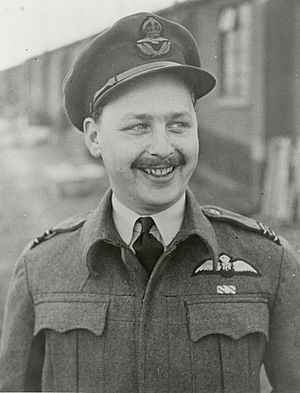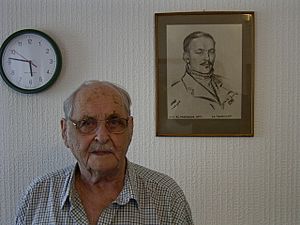John Freeborn facts for kids
Quick facts for kids
John Connell Freeborn
|
|
|---|---|

Squadron Leader John Freeborn, c. 1944
|
|
| Born | 1 December 1919 Middleton, Yorkshire |
| Died | 28 August 2010 (aged 90) Southport, Merseyside |
| Allegiance | United Kingdom |
| Service/ |
Royal Air Force |
| Years of service | 1938–1948 |
| Rank | Wing commander |
| Service number | 70854 |
| Unit | No. 74 Squadron RAF No. 602 Squadron RAF |
| Commands held | No. 118 Squadron RAF No. 286 Wing RAF |
| Battles/wars | Second World War |
| Awards | Distinguished Flying Cross & Bar |
| Other work | Regional Director for Minster Minerals soft drinks Author |
John Connell Freeborn (born December 1, 1919 – died August 28, 2010) was a brave fighter pilot. He was known as a flying ace in the Royal Air Force (RAF) during the Second World War.
In 1939, he accidentally shot down another RAF plane. This sad event caused the first death of an RAF fighter pilot in the war. It was also the first time a Supermarine Spitfire shot down another aircraft. The next year, he flew more hours than any other RAF pilot during the Battle of Britain.
Contents
Early Life and Joining the RAF
John Freeborn was born in a place called Middleton in West Yorkshire. His father, Harold, worked at a bank. His mother, Jean, was a serious person. John had five brothers and sisters.
His family moved to Headingley when he was very young. John went to Leeds Grammar School. He was smart and confident. But he didn't like strict rules and was happy to leave school.
Later, during the war, he flew a plane back to his old school. He put on an amazing air show. Then he landed right on the school's cricket field! He found it funny that his old teachers, who used to punish him, now told new students he was a great example.
John joined the RAF in January 1938. He learned to fly very quickly. He flew solo after only 4 hours and 20 minutes of practice. This was much faster than most pilots. He was also very good at shooting targets from the air. In October 1938, he joined 74 Squadron. From February 1939, he started flying the famous Spitfire planes.
In July 1939, John was one of the pilots from 74 Squadron. They flew Spitfires to France to celebrate Bastille Day with the French Air Force.
World War II Adventures
The Battle of Barking Creek Incident
On September 6, 1939, John Freeborn was part of an event called the Battle of Barking Creek. During this, two Hurricanes from another RAF squadron were shot down. They were hit by planes from John's own 74 Squadron. This was a sad case of "friendly fire." John shot down one of the planes, and the pilot, Montague Hulton-Harrop, died. This was the first plane destroyed by a Spitfire.
John felt bad about this for the rest of his life. He said he thought about the pilot almost every day. He wished the pilot could have lived a good life too.
Fighting Over Dunkirk
John's first real fight against enemy planes was over Dunkirk. He helped protect the British soldiers as they escaped from France. His squadron, 74 Squadron, was there for six days in May 1940. They shot down many enemy planes. John himself shot down two enemy aircraft.
During one fight, his plane was hit. He had to crash-land in France. He walked for several days, hiding from German soldiers. He even hid in a cemetery while machine-gun fire was close by. Finally, he reached Calais. A Blenheim plane took him back to England.
Hero of the Battle of Britain
John Freeborn fought bravely throughout the Battle of Britain with 74 Squadron. This was a very important air battle. On August 11, 1940, his squadron flew into battle four times in just eight hours! They destroyed 23 enemy planes. John shot down three of them. That evening, Winston Churchill himself came to congratulate the squadron.
On August 13, John shot down another enemy plane. But his own plane was also shot down that day. Luckily, he was not hurt. Because of his amazing flying skills, John became an "ace" during the Battle of Britain. He had shot down seven confirmed enemy planes.
He was given the Distinguished Flying Cross medal on August 13, 1940. This medal is for great bravery in air combat. His award said he showed "high courage and exceptional abilities as a leader."
A famous war artist, Cuthbert Orde, drew John's picture in August 1940. By the end of November, John had been with his squadron longer than any other Battle of Britain pilot. He had also flown more hours in combat.
Later War Service
John received another medal, a Bar to his Distinguished Flying Cross, in February 1941. This meant he had earned the medal again. The award said he had destroyed at least twelve enemy aircraft.
In June 1941, he started training new pilots. He taught them how to fly Spitfires. Later, after America joined the war, John went to the United States. He trained American pilots and tested new types of planes. He flew many different aircraft, including the P-51 Mustang and the B-17 Flying Fortress.
In December 1942, he came back to the UK. He flew Spitfires again with 602 Squadron. He helped protect bombers attacking German targets.
In June 1943, he became the leader of 118 Squadron. He continued to fly Spitfires. In June 1944, John Freeborn became the youngest flying wing commander in the RAF. He led 286 Wing in Italy. This was a very busy time, attacking German bases and protecting Allied forces.
John was always a very honest and direct person. He wasn't afraid to say what he thought.
Life After the War
After the war, John Freeborn left the RAF in 1946. He felt the RAF was not as good as it used to be. He had flown 42 different types of aircraft during his time in service.
In his civilian life, John first became a driving instructor. Then he worked for a soft drinks company as a regional director. He retired early and moved to Spain in the 1980s. But he later came back to the UK.
For many years, John didn't want to write down his life story. But he eventually agreed to talk to a military historian. This led to a book about his military career called A Tiger's Tale in 2002. Later, John wrote his own book, Tiger Cub, about his time in 74 Squadron.
John Freeborn passed away in Southport on August 28, 2010.
Personal Life
John Freeborn married Rita Fielder in early 1944. They had one daughter named Julia. Rita passed away in 1979. John married his second wife, Margaret Ena (known as Peta) Thomas, in 1983. She died in 2001.
Images for kids




